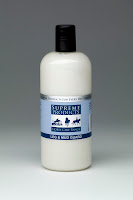Mud Fever occurs during the wet winter months and is principally caused by the bacteria Dermatophilus Congolensis. This is a form of dermatitis that affects the skin on the heel, fetlock and pastern. All horses can be affected, but particularly those with long hair around the fetlock are at risk. Back legs are more prone to mud fever than front legs and horses with thin skin, white heels or a lot of feather are also more likely to be susceptible to the condition.
Inflammation of the skin and underlying tissues leads to the skin swelling, stretching and weeping; cracks appearing, the hair falling out and hard scabs forming.
Horses exposed to a muddy environment or those that are kept in a dirty or unsatisfactory condition are more susceptible to Mud Fever. It can be a time-consuming and difficult condition to treat, with efforts to manage the symptoms often frustrated when the owner has no choice but to turn horses back out into the field or paddock that aggravated the condition in the first place.
How to prevent Mud Fever:
Although it is not possible to guarantee complete protection, half the battle lies in effective preventive treatment.
• To try to prevent mud fever, keep your horses' legs as clean and dry as possible.
• Hosing should not cause problems, providing the legs are dried thoroughly afterwards – using a hairdryer can often be the most effective way!
• Horses with thin skin, white heels or a lot of feather are likely to be more susceptible to the condition. If horses are turned out, it is advisable to keep their feathers clipped. Clip them – don’t shave them.
• Stable the horse on clean bedding and provide good living conditions.
• Use a topical barrier cream such as Supreme Products Leg & Mud Guard on clean, dry legs or underside of the belly prior to turnout or exercise.
Inflammation of the skin and underlying tissues leads to the skin swelling, stretching and weeping; cracks appearing, the hair falling out and hard scabs forming.
Horses exposed to a muddy environment or those that are kept in a dirty or unsatisfactory condition are more susceptible to Mud Fever. It can be a time-consuming and difficult condition to treat, with efforts to manage the symptoms often frustrated when the owner has no choice but to turn horses back out into the field or paddock that aggravated the condition in the first place.
How to prevent Mud Fever:
Although it is not possible to guarantee complete protection, half the battle lies in effective preventive treatment.
• To try to prevent mud fever, keep your horses' legs as clean and dry as possible.
• Hosing should not cause problems, providing the legs are dried thoroughly afterwards – using a hairdryer can often be the most effective way!
• Horses with thin skin, white heels or a lot of feather are likely to be more susceptible to the condition. If horses are turned out, it is advisable to keep their feathers clipped. Clip them – don’t shave them.
• Stable the horse on clean bedding and provide good living conditions.
• Use a topical barrier cream such as Supreme Products Leg & Mud Guard on clean, dry legs or underside of the belly prior to turnout or exercise.
• Try using waterproof leg wraps for turnout or exercise
The Symptoms
If you are not able to prevent mud fever, you need to know how this can be combated. One of the first things, however, is to be able to recognise the condition. The signs of mud fever are fairly classic and easy to recognise, with the distribution of the lesions being most prominent and visible in the areas that have been subjected to the wettest conditions.
• Matted areas of hair containing crusty scabs
• Small, circular, ulcerated, moist lesions beneath scabs
• Thick, creamy, white, yellow or greenish discharge between the skin and overlying scab
• The scab, once removed, often has the hair roots protruding
• Deep fissures in the skin
• Eventual hair loss leaving raw-looking, inflamed skin underneath
• Heat, swelling and pain if pressure is applied to the limb or the limb is flexed or stretched
• Lameness
• If severely affected, lethargy, depression and loss of appetite
How to Combat Mud Fever
• Remove the scabs to treat the skin, but be aware that doing this forcibly could aggravate the surrounding tissue and be painful as well as creating discomfort. Use Supreme Products Horse Care Cream to soften the scabs so they fall away naturally.
• Prevent skin from coming into further contact with wet or muddy earth while the condition is being treated. Horses should be stabled on clean, dry bedding and should not be allowed to stand in damp bedding or litter.
• When the scabs have been removed, shampoo your horses’ legs with Supreme Products Medicated Shampoo from the Horse Care Range to fight the bacteria. Make sure, once rinsed, that you dry the legs thoroughly.
• Immunise your horse against Tetanus.
• Consult your vet if the symptoms persist as antibiotics may be required.
• Try to avoid turnout in very damp conditions, use a ménage if you have one or turn out in a well-drained paddock.
• Use Supreme Products Leg & Mud Guard as a barrier cream to try to prevent further occurrences.




If your animal is susceptible to mud fever, rain scald or thrush, a twice weekly maintenance spray is recommended.If your horse is suffering from minor skin abnormalities caused by greasy heel, rain scald and thrush, place your order for equinecare probiotic spray on our website https://equinecareprobiotic.com.au
ReplyDelete